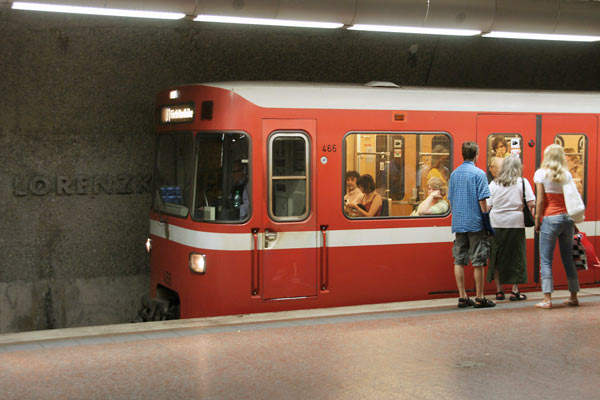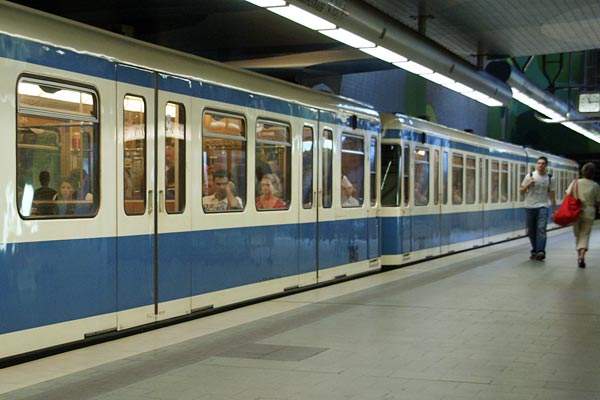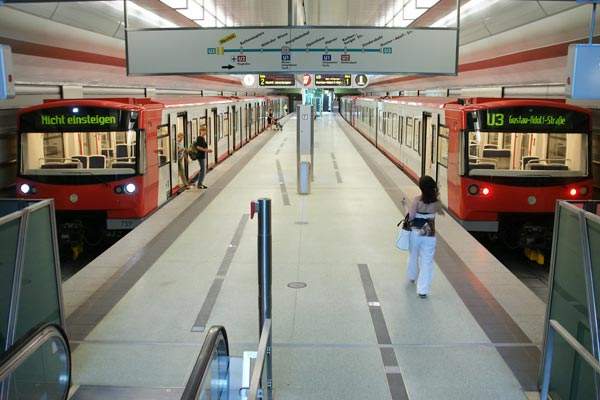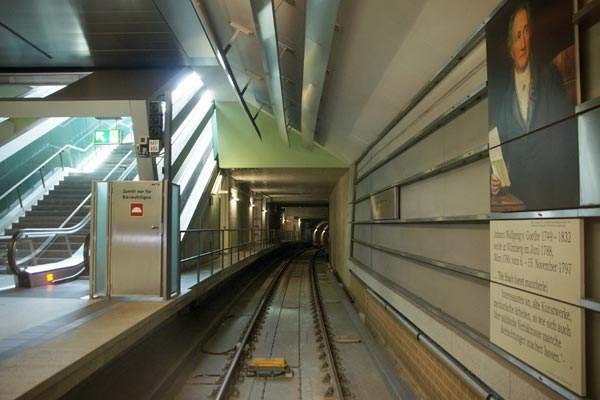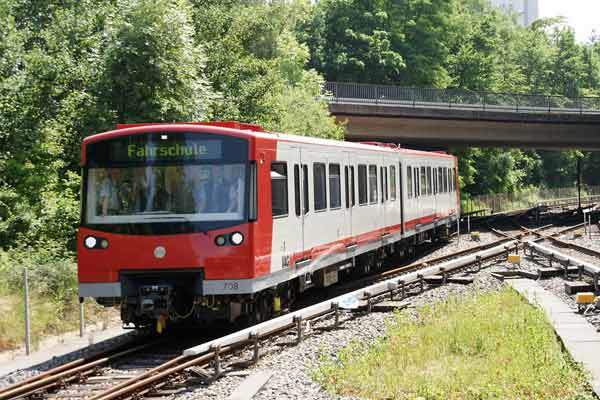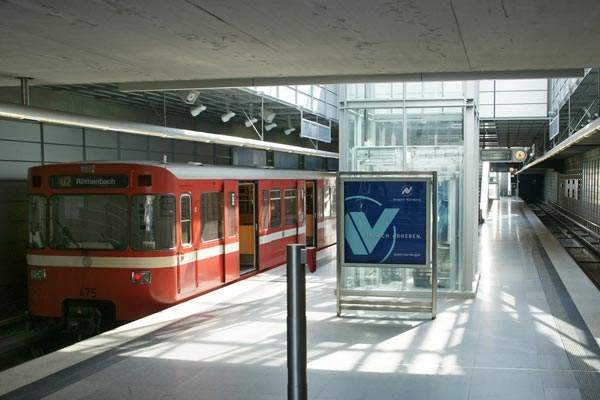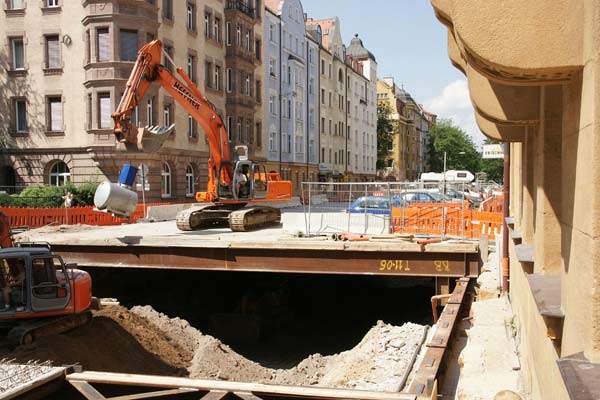Nuremberg (Nürnberg) is the second city of the German state of Bavaria (Bayern), with a population of half a million, or 800,000 if including adjoining communities such as Fürth and Erlangen. These are covered by the public transport authority Verkehrsverbund Grossraum Nürnberg (VGN).
Bus, U-Bahn and tram services are operated by city-owned VAG (Verkehrs-Aktiengesellschaft). Nuremberg is a focal point for DB mainline services and since 2007 is at the northern end of an ICE Neubaustrecke to Ingolstadt on the Munich route, part of the projected high-speed line to Berlin.
Construction started in 1967, and the U-Bahn (underground/metro) opened in 1972 with 3.7km of line U1, with many extensions following. Like its predecessor with successive extensions, the first part of U2 began operations in 1984, reaching the international airport over the longest unbroken section on the system in 1999.
THE PROJECT
Developed as a project under the RUBIN acronym (Realisierung einer automatisierten U–Bahn in Nürnberg), in 1997 VAG had launched a feasibility study involving Siemens, Adtranz (later Bombardier) and local interests for an automatic metro operation.
Construction of U3 began in 2003, although the project was subject to two years of delays mainly relating to the automatic train control (ATC) system.
By its opening as a public service in June 2008, Nuremberg U-Bahn became Germany’s first automatic metro line and the first in the world to operate manually driven and automatic service trains over the same tracks.
The move to driverless operation was motivated by reduced operating costs; the chance to automate while re-equipping with more modern higher capacity rolling stock and the facility to take stock into/from service near-instantly according to demand. Another key objective was to use the more precise operation of automatic trains to increase frequencies on the core section of the inter-related U2 and U3 lines.
The contract to enable these lines to be readied for automatic operation was awarded to Siemens Transportation Systems in November 2001, including the supply of 30 new driverless trains. Siemens was an established presence in automatic systems through its involvement with VAL, Lyon Metro Line D, Paris Metro Line 14 and the Düsseldorf/Dortmund H-Bahn projects.
ROLLING STOCK
Three classes of stock (DT1-DT3) exist on the system, the earliest type bolstered by six units acquired from the Munich system in 2004. Intended from the outset for automatic operation, the DT3 were built by Siemens in Vienna. Commissioning delays meant that deliveries from 2004 proved to be well in advance of their fleet application as intended on U3.
Maintaining the system’s previous two-car set configuration, regularly operated in pairs, the DT3 added through-gangways within sets for better load distribution and improved supervision and security. Without driving compartments, there is an unobstructed view from the vehicles ends which have manual driving controls concealed within lockable units.
Automatically extending flaps on the stock aid access from platform to trains for wheelchairs and pushchairs, the system as a whole being very accessible with lift connections at all stations. The trains have a large general-purpose area aimed at encouraging access and bicycle users. VAG has a service life expectation of 35 years for the DT3 ‘Pegnitzpfeile’ (Pegnitz Arrow) class.
INFRASTRUCTURE
Most of Nuremberg U-Bahn is sub-surface, with some open sections on U1. The U1 and U2/U3 routes cross twice and in close proximity east and west of the city centre, one intersection being at Nuremberg’s busiest public transport interchange, the Hauptbahnhof. This location brings together main line, metro, bus and tram services, the last three modes operated by VAG.
Most track is unballasted and the system mainly uses island platforms of consistent length relating to standardised train lengths. Designations U11 and U21 on system maps relate to trains making shorter runs over lines U1 and U2 rather than separate lines.
The new U3 is largely based upon U2 tracks between Rathenauplatz and Rothenburger Strasse, the new route being formed from the shared section and new branches at either end respectively to Maxfeld and Gustav Adolf Strasse.
SIGNALLING AND COMMUNICATIONS
Unlike many automatic systems, Nuremberg is not equipped with platform edge doors due to disruptions that would be caused by the fitment, also the difficulty of reliably aligning the manually driven U2 trains with door openings. In the event of a sudden track obstruction at the station platforms, a detection system interlocks with the ATC for emergency stops and alerts the control centre which has CCTV coverage of all areas.
The Siemens ATC system for Nuremberg had to take account of the mixed operation by automatic and conventionally driven trains. The full potential for 100-second frequency will however only become available with U2 and U3 lines and trains running automatically.
Trains are fitted with CCTV monitoring and audio intercom for communication with the control centre. Ticketing follows the usual German system covering different modes and operators, the VGN tariff union also being covered by the DB Bayern Lände ticket.
THE FUTURE
After a period of test running, public operations on U3 began in May 2008, with the official opening on 14 June. Subsequently other VAG services were realigned to take account of the new route.
Construction of the U3 line beyond Maxfeld, with two stations was completed in December 2011 and two more are expected to be completed in the northern part of U3 by 2013. By the same time, a southern extension towards Fürth should also be in operation. The U2 line was fully converted to automatic operation in September 2009. A further U1 lengthening has been shelved due to anticipated developments in the target area not having occurred.
Although the Rubin/U3 project has been subject to delays, Nuremberg has demonstrated that existing metro systems can be converted to automatic operation and while maintaining services, a market with worldwide potential.


